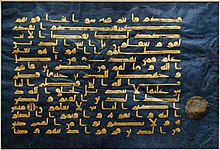Blue Quran
[1] The dating, location of origin, and patron of the Blue Quran are unknown and have been the subject of academic debate, though it is generally accepted that the manuscript was produced in the late 9th to mid-10th century in either Kairouan, Tunisia or Cordoba in Umayyad Spain.
[1] The Blue Quran was written in Kufic script, characterized by sharp angles and the absence of vowel markings.
[7] However, research done by scholar Cheryl Porter, whose work focuses on the use and technical implementation of color in manuscripts, has determined that the dye was likely brushed onto the parchment before it was stretched and dried.
This was first proposed by Frederik R. Martin, a Swedish diplomat and dealer, who introduced the Blue Quran to the academic community.
[8] He claimed that he obtained some of the manuscript's pages in Constantinople and that it originated in Mashhad, Persia, where they were commissioned for the tomb of the 9th-century Abbasid caliph Harun al-Rashid.
On the other hand, the Blue Quran was included in the inventory of the Great Mosque of Kairouan, which places the manuscript in Tunisia around 1300 CE.
[10] While this does not confirm that the manuscript was created in Tunisia, scholars argue that transporting the Blue Quran in its entirety over a long distance would be unlikely.
One theory is that an Umayyad patron commissioned the Blue Quran and that the manuscript was created by Christians, who have a greater tradition of writing their sacred texts on dyed parchment than Muslims.
[14] Several of the detached folios have also been sold at major British auction houses Christie's and Sotheby's in the 2010s, carrying a price of hundreds of thousands of dollars apiece.
[19] Art historian Yasser Tabbaa wrote that the "evanescent effect" of the gold lettering on the blue parchment "appears to affirm the Mu'tazili belief in the created and mysterious nature of the Word of God.


